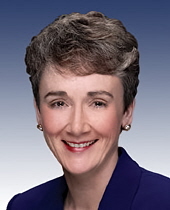2009 Voting Record of Female Republicans in U.S. House Most Conservative in History
Analysis finds National Journal vote rankings of female GOP Representatives set record highs for conservatism in 2009

To be sure, several Republican women are ranked prominently among the Top 50 most conservative members of the U.S. House in National Journal’s latest rankings, based on key votes cast in 2009. Marsha Blackburn (pictured, TN-07) ranks as the most conservative female Representative at #7, followed by Virginia Foxx (NC-05, #19), Michele Bachmann (MN-06, #28), Cynthia Lummis (WY-AL, #34), Sue Myrick (NC-09, #34), Kay Granger (TX-12, #41), and Mary Fallin (OK-05, #42).
The votes cast by these and the 10 remaining female GOPers in the House made history last year.
A Smart Politics analysis of 29 years of National Journal ideological vote rankings finds that the female Republican members of the U.S. House in 2009 notched both the highest composite conservative score on record and the highest conservative scores for key votes on economic and social policy legislation.
Moreover, the current group of Republican women in the U.S. House are continuing a half-decade long trend which finds them ranking more and more conservative as a group – GOP women are now voting more conservatively than 77 percent of the House as a whole.
In 2009, Republican women as a bloc voted more conservatively than 77.4 percent of the U.S. House as a whole on economic, social, and foreign policy issues. This number has risen steadily since 2004.
In that year, the 21 GOP Representatives voted more conservatively than 68.7 percent of the House as a whole, rising to 70.9 percent in 2005, 72.8 percent in 2006, 74.1 percent in 2007, and 74.9 percent in 2008.
By comparison, when National Journal began its annual ideological vote tracking in 1981, the 10 female Republican Representatives in office that year voted more conservatively than just 54.9 percent of the House as a whole.
Republican women notched their most conservative voting record relative to their peers to date in 2009 on both economic issues (voting more conservative than 77.8 percent of the House) and on social policy (76.0 percent).
Key votes cast by female GOPers on foreign policy issues were the fourth most conservative on record in 2009 (70.2), behind 2008 (75.0), 2006 (74.3), and 2003 (70.5).
This conservatism by Republican women in the U.S. House continues what has been a pattern over the past half decade: female GOPers ranking more and more conservative as a group relative to the House as a whole.
In 2004, female Republican Representatives had an average conservative ranking of 137. In other words, they collectively voted more conservatively than approximately 69 percent of the 435-member body. That number rose to an average conservatism ranking of 127 in 2005, 116 in 2006, 109 in 2007, and 108 in 2008.
By 2009, the 17 Republican women in office had an average conservative ranking of 97 – 40 slots higher than they did just five years prior. That means female GOP Representatives as a collective voted more conservatively than approximately 77 percent of the House as a whole last year.
Average Conservative Ranking for Female Republican U.S. Representatives, 2004-2009
|
Year
|
Average rank
|
|
2004
|
137
|
|
2005
|
127
|
|
2006
|
116
|
|
2007
|
109
|
|
2008
|
108
|
|
2009
|
97
|
National Journal data compiled by Smart Politics.
Several factors have contributed to the greater conservative ‘purity’ of the female Republicans in the U.S. House in recent years.
First, new Republicans have been elected to the body during the last few years who have clearly marked out very conservative territory in their voting record, such as Michele Bachmann (MN-06) and Mary Fallin (OK-05).

A third factor has been the departure from the U.S. House of more moderate (frequently Northeastern) Republican female Representatives during the last few years, such as former Representatives Nancy Johnson (CT-05), Sue Kelly (NY-19), and Deborah Pryce (OH-15). All three of these women frequently ranked at approximately the 200th most conservative member of the House.
Combined, these factors have helped transform the voting record of female GOPers such that in 2004, 10 of the 21 Republican women in the US House had an overall conservative ranking of #150+. In 2009, just 6 of the 17 GOP women were ranked at #150+, with 7 in the Top 50.
The rise in conservative voting by Republican women across the last three decades has been evident in all three of the general issue areas tracked by National Journal – particularly in social and foreign policy.
From 1981 to 1990, GOP women voted more conservatively than 55.6 percent of the House on social policy legislation. That number increased to 57.2 percent from 1991-2000 and then rose substantially to 67.3 percent from 2001-2009.
A more conservative foreign policy voting record has also been tracked across the decades. Republican women voted more conservatively than 56.1 percent of the House as a whole from 1981-1990, than 65.1 percent from 1991-2000, and 69.9 percent from 2001-2009.
Economic policy has seen the least dramatic shift. Republican women voted more conservatively than 67.4 percent of the House from 1981-1990, than 66.2 percent from 1991-2000, and 71.8 percent from 2001-2009.
Female Republican U.S. Representative Conservatism Ratings by Issue by Decade
|
Years
|
Economic
|
Social
|
Foreign
|
Composite
|
|
1981-1990
|
67.4
|
55.6
|
56.1
|
61.1
|
|
1991-2000
|
66.2
|
57.2
|
65.1
|
65.0
|
|
2001-2009
|
71.8
|
67.3
|
69.9
|
71.6
|
National Journal vote data compiled by Smart Politics. Data indicates the percentage of Representatives of which female GOPers are more conservative by issue.
Overall, the number of Republican women in the U.S. House is at a decade-long low. At just 17 members in 2009, the number of female GOPers has declined 32 percent from 2006, when 25 Republican women served in the House.
The number of female Republicans in the House had risen gradually from 16 in 1997, to 17 in 1998, to 18 in 2001, to 21 in 2003, to 23 in 2005, to 25 in 2006. That number dropped quickly to 21 in 2007 after the previous November’s election.
Female Republican U.S. Representative Conservatism Ratings by Issue, 1981-2009
|
Year
|
Economic
|
Social
|
Foreign
|
Composite
|
#
|
|
1981
|
65.5
|
51.1
|
45.1
|
54.9
|
10
|
|
1982
|
58.3
|
49.7
|
48.6
|
53.4
|
10
|
|
1983
|
75.0
|
58.3
|
57.7
|
65.1
|
9
|
|
1984
|
67.6
|
59.1
|
58.4
|
63.5
|
9
|
|
1985
|
70.5
|
51.1
|
57.9
|
62.6
|
11
|
|
1986
|
73.5
|
59.8
|
61.0
|
66.8
|
11
|
|
1987
|
66.8
|
60.9
|
58.3
|
63.0
|
11
|
|
1988
|
64.0
|
54.2
|
57.3
|
59.2
|
11
|
|
1989
|
67.3
|
53.5
|
58.3
|
60.8
|
12
|
|
1990
|
65.2
|
57.8
|
59.3
|
61.8
|
13
|
|
1991
|
66.3
|
58.8
|
61.8
|
63.3
|
9
|
|
1992
|
70.7
|
57.2
|
60.9
|
65.1
|
9
|
|
1993
|
58.8
|
50.2
|
61.7
|
59.0
|
12
|
|
1994
|
66.5
|
62.3
|
67.6
|
67.0
|
12
|
|
1995
|
64.2
|
56.9
|
68.0
|
67.6
|
17
|
|
1996
|
66.2
|
53.2
|
66.6
|
65.2
|
17
|
|
1997
|
66.9
|
60.2
|
68.0
|
66.9
|
16
|
|
1998
|
64.2
|
61.7
|
68.2
|
66.0
|
17
|
|
1999
|
69.1
|
56.5
|
63.0
|
64.5
|
17
|
|
2000
|
69.4
|
54.9
|
65.3
|
65.3
|
17
|
|
2001
|
67.6
|
57.6
|
69.2
|
66.8
|
18
|
|
2002
|
68.9
|
57.1
|
66.4
|
66.9
|
18
|
|
2003
|
72.4
|
66.4
|
70.5
|
71.5
|
21
|
|
2004
|
68.5
|
66.3
|
68.4
|
68.7
|
21
|
|
2005
|
72.3
|
68.0
|
68.7
|
70.9
|
23
|
|
2006
|
69.1
|
71.1
|
74.3
|
72.8
|
25
|
|
2007
|
75.6
|
72.1
|
66.8
|
74.1
|
21
|
|
2008
|
74.4
|
71.5
|
75.0
|
74.9
|
20
|
|
2009
|
77.8
|
76.0
|
70.2
|
77.4
|
17
|
National Journal vote data compiled by Smart Politics. Data indicates the percentage of Representatives of which female GOPers are more conservative by issue.
Follow Smart Politics on Twitter.

I feel educated lol